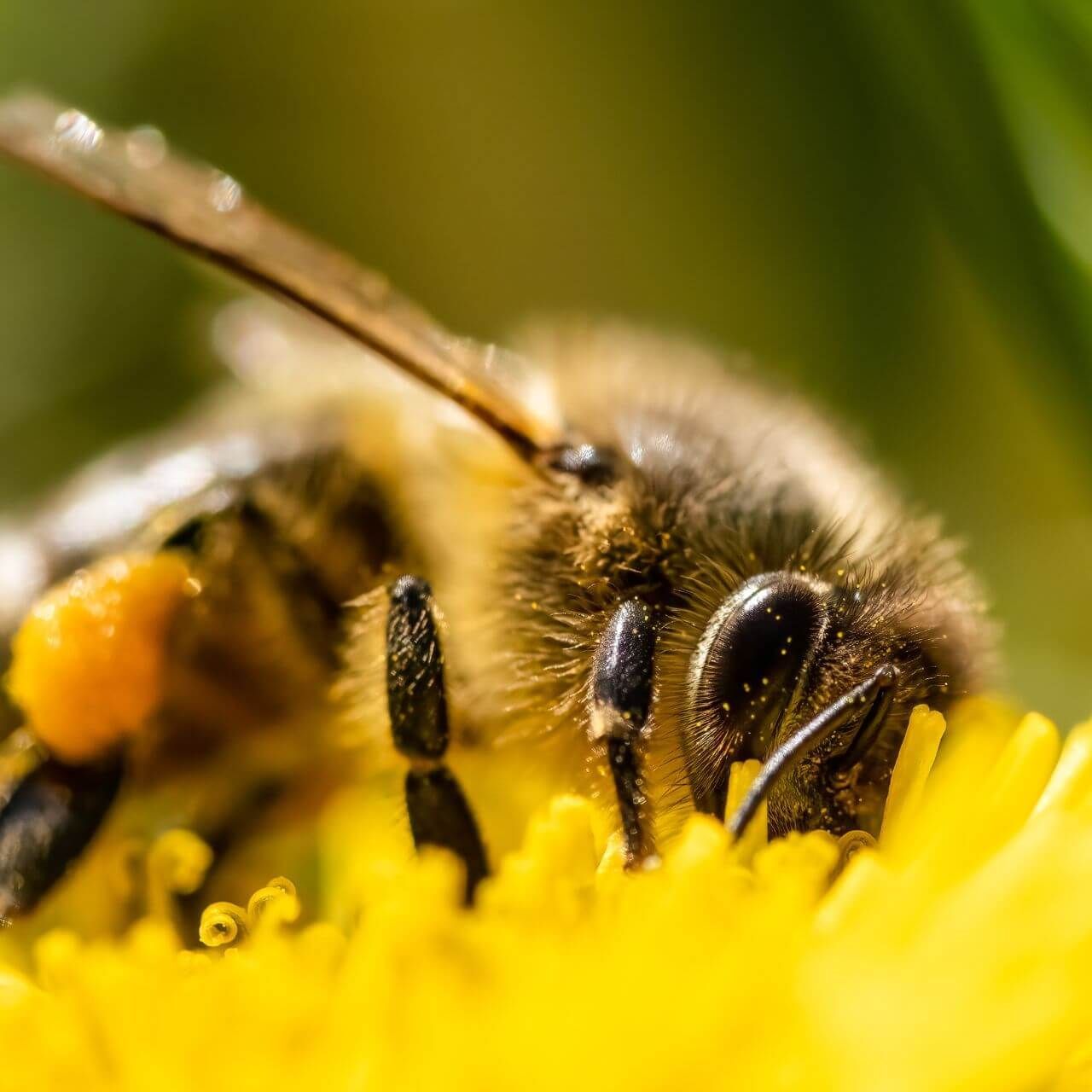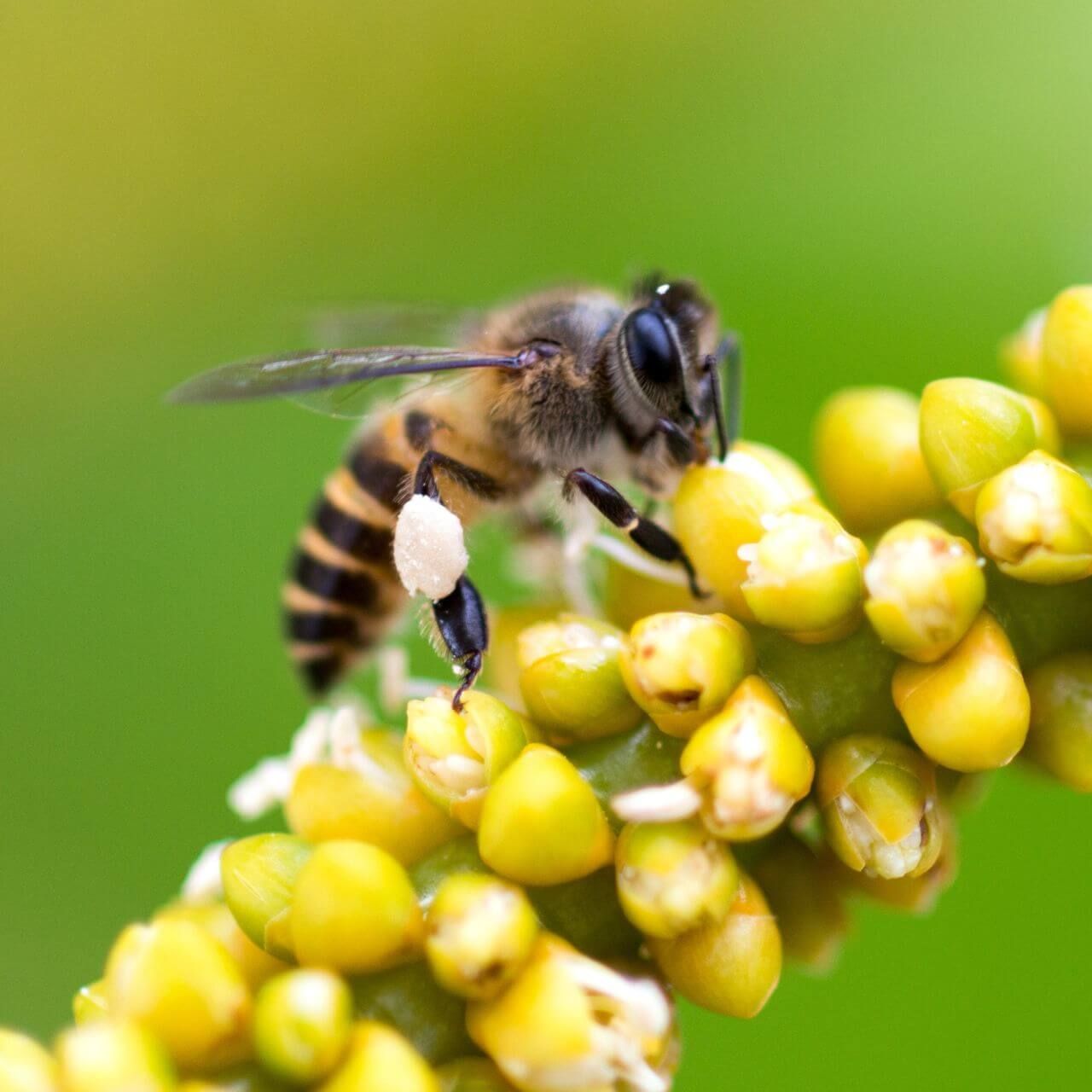Bees

Let's Learn About Bees
Word of the Week
Proboscis
Many nectar-drinking insects use a straw-like structure called a proboscis to suck up nectar.
Butterflies, moths, and bees all drink nectar with a proboscis.
Fast Facts

Where do bees live?
Bees live on every continent except Antarctica.
They are found in almost every type of habitat, including deserts, rainforests, grasslands, and even tundras.
What do bees eat?
Bees drink nectar and eat pollen.
Bees use their straw-like proboscis to slurp up sugary nectar for energy. Some bees also eat pollen which provides protein. Many species collect pollen and carry it back to their shelter in basket-like structures on their legs.


What traits do bees share?
Bees are a group of insect that...
- Have 6 legs and 3 body segments.
- Detect chemicals (smell/taste) with antennae.
- Have compound eyes.
- Often have hair-like structures called setae that sense vibrations.
How many bees are there?
There are more than 20,000 species of bees!
It is important that bee populations stay healthy because they are one of the most important pollinators in the world. Many species of bees are threatened by the use of pesticides, climate change, habitat loss, and many other factors.

Species Spotlight
Bumblebee
Bombus ssp.
While some bees have a bad reputation, that is not the case for adorable bumble bees. These flower-visiting, fuzzy insects have been inspiring designs for children’s clothing, kitchen gadgets, and more for decades. More than 250 species of bumble bees live across North and South America, Europe, Asia, and the northern part of Africa.
Their fuzzy bodies are not actually covered in hair. The bristle-like structures are called setae. Bumble bees use them to sense vibrations around them. They have other ways to sense the world, like with their antennae. They use antennae to detect chemicals, otherwise known as smelling or tasting. They use their antennae to find food, like nectar and pollen. They use their long proboscis to slurp nectar into their mouths like a straw. Many species have basket-like sections of their legs that carry pollen.
While most bees are solitary, bumble bees are social. They live in large colonies with a single queen. Their colonies tend to be smaller than honeybees, sometimes only reaching 50 individuals. They work together to find and collect food, protect the hive, and care for their offspring.
Like many other nectar-drinking animals, bumblebees are important pollinators. Their “furry” body traps pollen as they travel between flowers. As they reach new flowers, some pollen falls off. Pollination is important because it allows plants to create seeds and fruit. Next time you see a bumblebee, be sure to thank them for all of their pollination!
Conservation Corner
Building a Bee-Friendly Yard
If you spend time outside on a warm, sunny day, there’s a good chance you might see bees flying, ants crawling, or beetles climbing. One of the best parts about summer is the abundance of wildlife, both big and small, taking advantage of the warm temperatures and plentiful food. Bees and butterflies travel from flower to flower pollinating native plants. Ants and worms crawl through the soil spreading nutrients. Beetles and flies make great snacks for native birds and lizards!
Because bugs have so many important jobs, like pollinating, spreading nutrients, and providing food for other animals, they are helpful to have around! There are many ways you can encourage bugs to live in your area. Here are two examples.
- Build a bug house: Many insects look for small, safe spaces to rest or lay their eggs. Bugs look for shelter in small small holes or cracks or crevices in wood. While there are many bug houses you can buy, they are also easy to make.
- Create a bug-friendly water source: Many insects search for clean, fresh water, especially in the summer. Using a shallow water dish and rocks, you can create the perfect place for them to get hydrated.
-
Visit the challenge activities below to learn how to make a bug house and a bug-friendly water dish.
To Bee or Not to Bee
Determine if each trait below describes bees or does not describe bees.
Learn More!
Glossary
Adaptation
The process by which a species becomes more fit for its environment over the course of several generations. It is a result of natural selection.
Antenna
An organ on the head of insects used to sense touch, smell, and taste.
Arthropod
A large group of invertebrates consisting of insects, arachnids, myriapods, and crustaceans.
Burrow
An underground, tunnel-like shelter.
Compound Eyes
Complex organs used by some insects and crustaceans (like crabs) to see by collecting many tiny images to gain a wide view.
Exoskeleton
A hard exterior that supports and protects many species of invertebrates.
Insect
A class of invertebrates with 6 legs, 2 body segments, and a pair of antennae.
Invertebrate
An animal that has no bones.
Nectar
A sweet, sugary liquid produced by flowers.
Ovipositor
The structure used by insects to deposit eggs.
Pollen
A small, grain-like substance produced by a flower's anther that is used in fertilization of the flower.
Pollination
The movement of pollen from the male part of a plant (anther) to the female part (stigma) to make fertile seeds.
Predator
An animal that hunts other animals for food.
Prey
An animal that is hunted and eaten by another animal.
Proboscis
A straw-like structure used by many insects to slurp up nectar.
Setae
Hair-like structures used by some invertebrates to detect vibrations.
Social
Living in a group with other members of the same species.
Solitary
Describing an animal that lives alone.
Species
A closely related group of animals with similar characteristics that are capable of reproducing (example: tigers).
Venom
A toxin that is injected into prey through teeth or a stinger.
Vertebrate
An animal that has a backbone.





